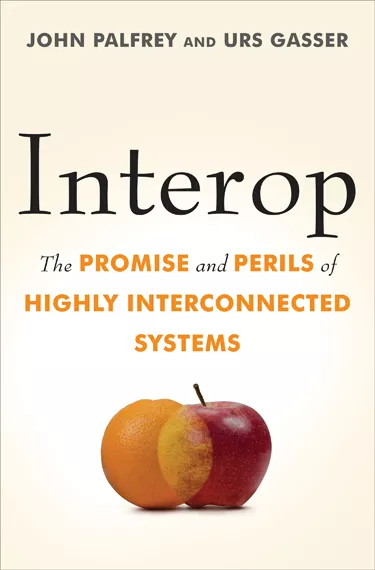
Interop: The Promise and Perils of Highly Interconnected Systems
Please find below a description of the book, four full book chapters, and links to book reviews, guest commentary by John and Urs, and links to interactive Interop.
In Interop, technology experts John Palfrey and Urs Gasser explore the immense importance of interoperability—the standardization and integration of technology—and show how this simple principle will hold the key to our success in the coming decades and beyond.
The practice of standardization has been facilitating innovation and economic growth for centuries. The standardization of the railroad gauge revolutionized the flow of commodities, the standardization of money revolutionized debt markets and simplified trade, and the standardization of credit networks has allowed for the purchase of goods using money deposited in a bank half a world away. These advancements did not eradicate the different systems they affected; instead, each system has been transformed so that it can interoperate with systems all over the world, while still preserving local diversity.
As Palfrey and Gasser show, interoperability is a critical aspect of any successful system—and now it is more important than ever. Today we are confronted with challenges that affect us on a global scale: the financial crisis, the quest for sustainable energy, and the need to reform health care systems and improve global disaster response systems. The successful flow of information across systems is crucial if we are to solve these problems, but we must also learn to manage the vast degree of interconnection inherent in each system involved. Interoperability offers a number of solutions to these global challenges, but Palfrey and Gasser also consider its potential negative effects, especially with respect to privacy, security, and co-dependence of states; indeed, interoperability has already sparked debates about document data formats, digital music, and how to create successful yet safe cloud computing. Interop demonstrates that, in order to get the most out of interoperability while minimizing its risks, we will need to fundamentally revisit our understanding of how it works, and how it can allow for improvements in each of its constituent parts.
In Interop, Palfrey and Gasser argue that there needs to be a nuanced, stable theory of interoperability—one that still generates efficiencies, but which also ensures a sustainable mode of interconnection. Pointing the way forward for the new information economy, Interop provides valuable insights into how technological integration and innovation can flourish in the twenty-first century.
Book Chapters:
The following four full book chapters are accessible for free as PDFs.
Book Reviews:
- The Faculty Lounge
- Library Journal
- Nature
- Publishers Weekly
- Science
- Slate
- The Technology Liberation Front
- Times Higher Education
Guest Commentary by John and Urs:
Interactive Interop:
- Audio and video from John and Urs' Interop book talk at Harvard Law School.
- RadioBerkman 204: The Art and Science of Working Together brings John, Urs, and David Weinberger together in conversation about how Interoperability works, and how interoperable systems can lead to greater innovation, greater efficiency, and better functioning societies.
- An interactive Interop presentation on Zeega includes videos with the authors and information about the interop behind Interop, created by Berkman summer 2012 interns Gabbi Fisher, Shaun Geer, Luca Piccin, and Gili Vidan.

